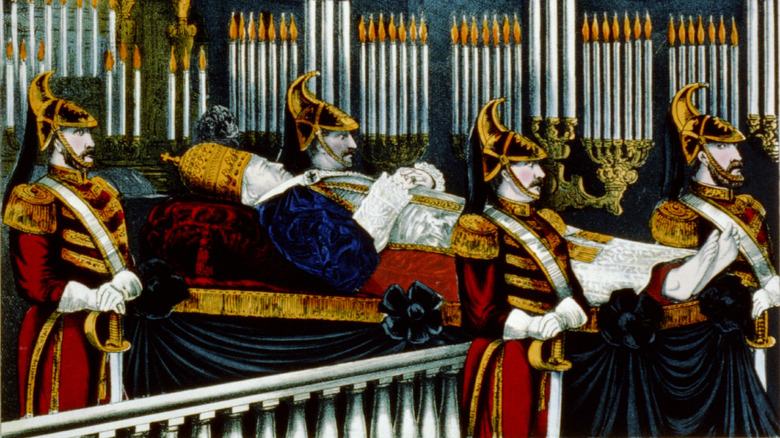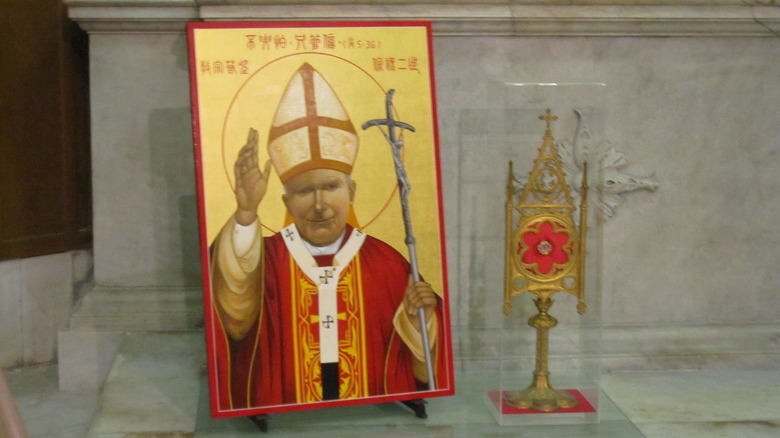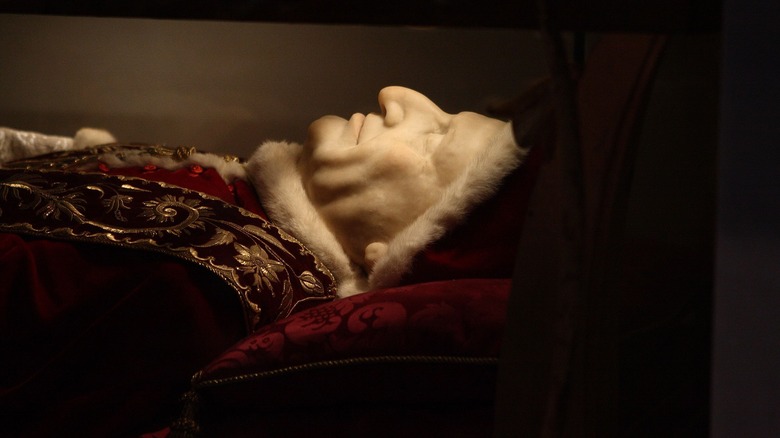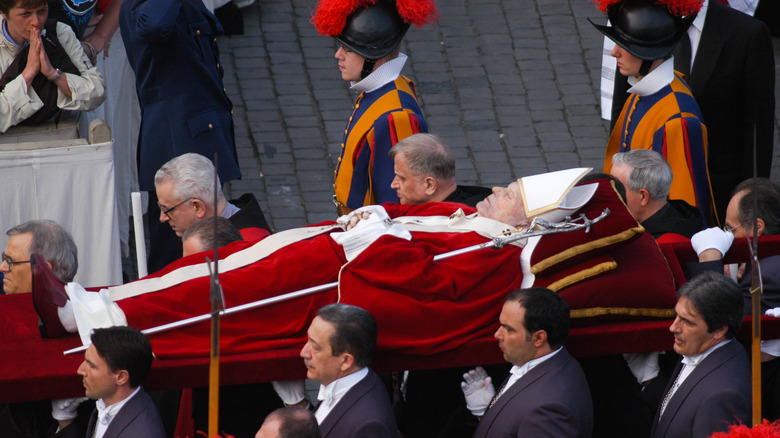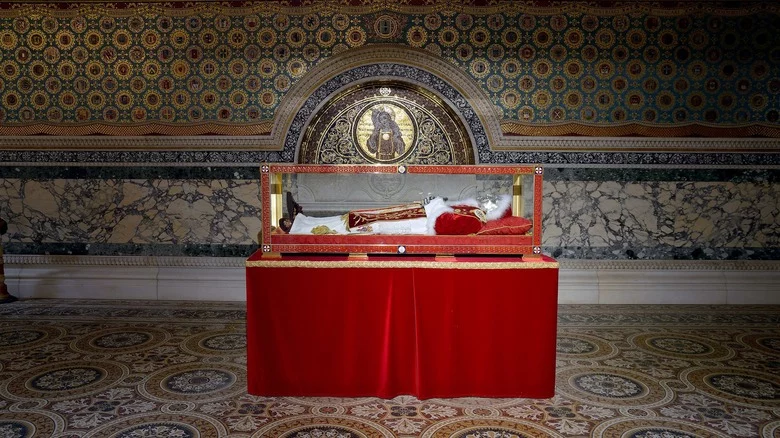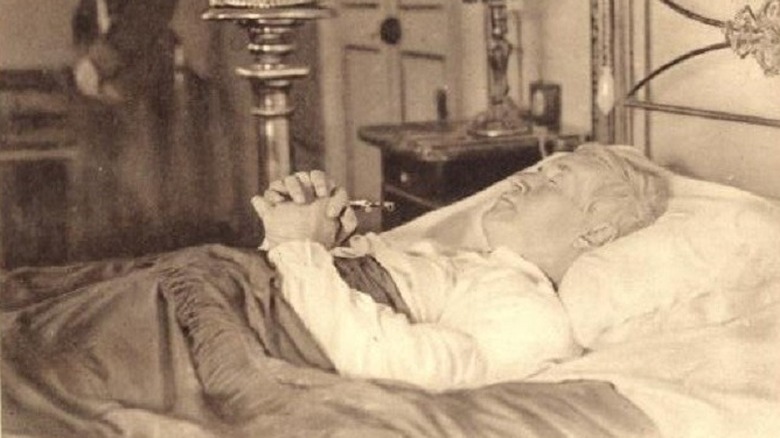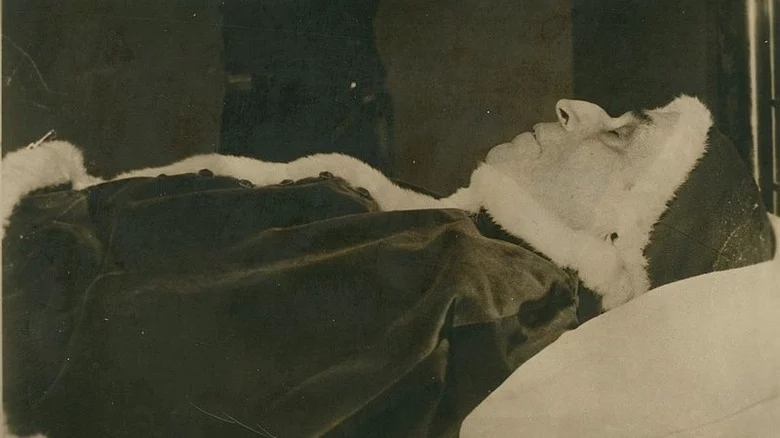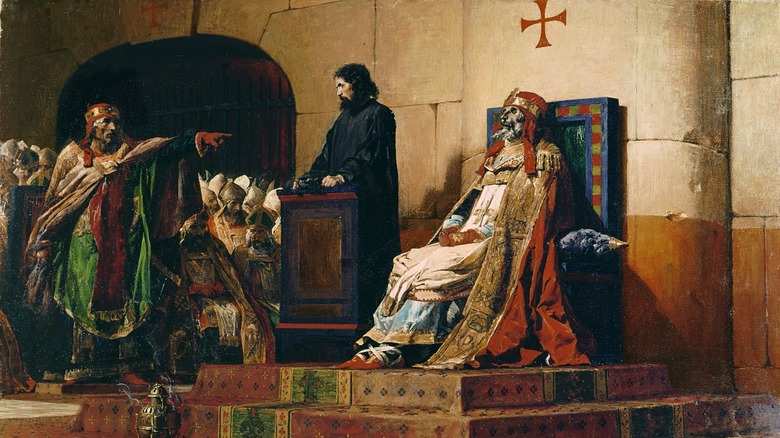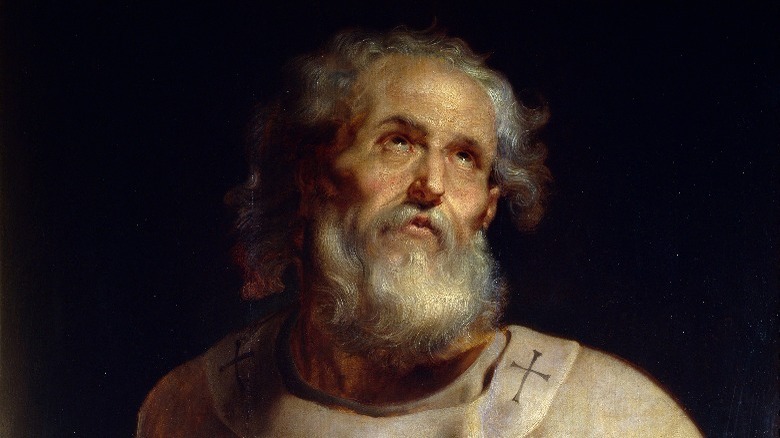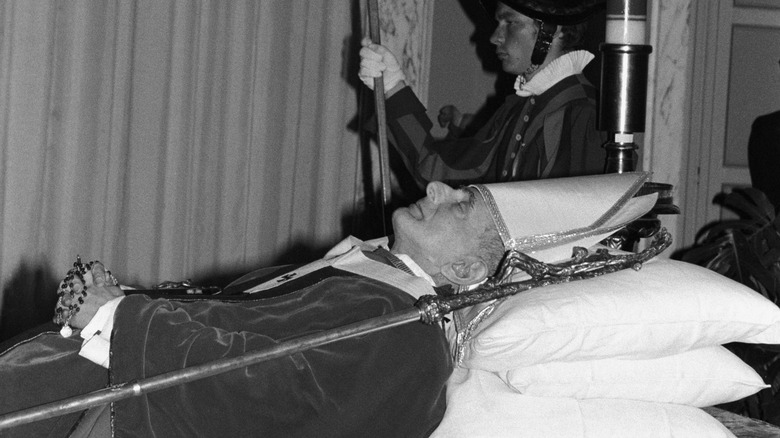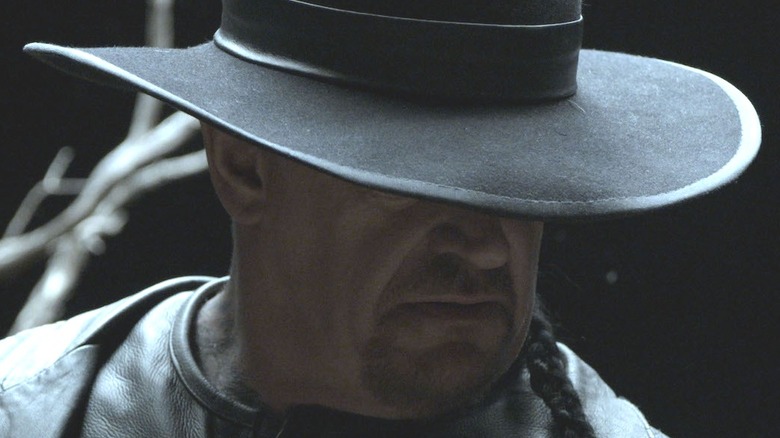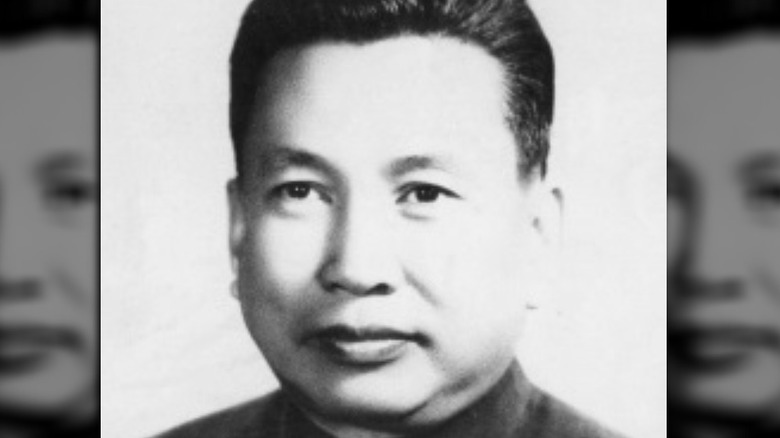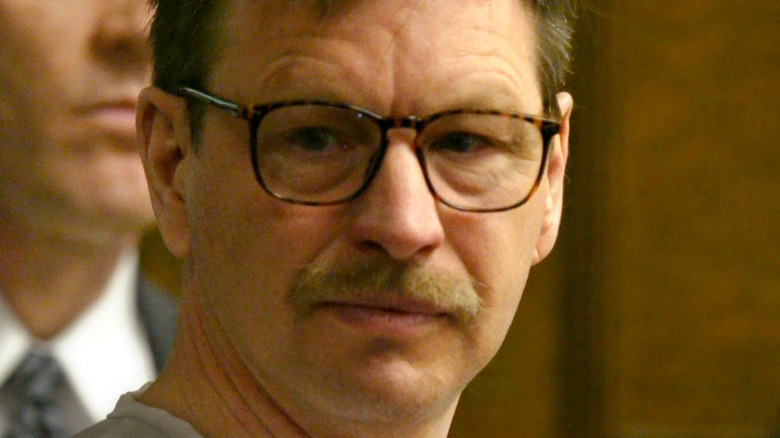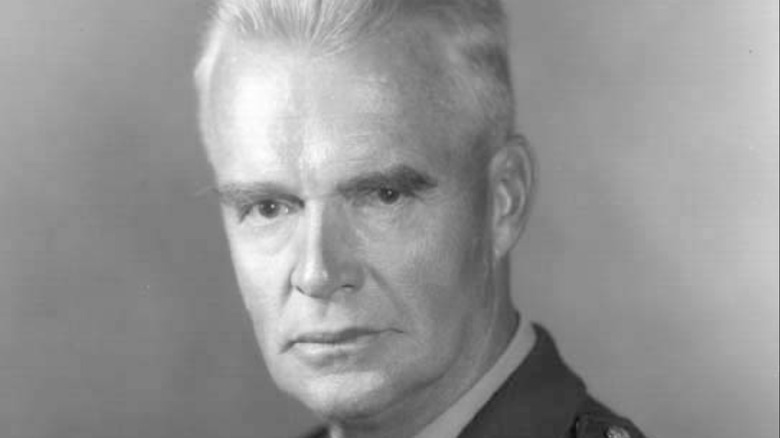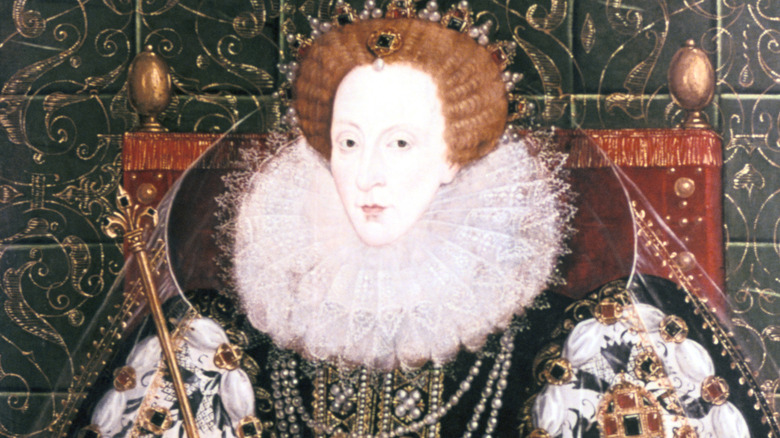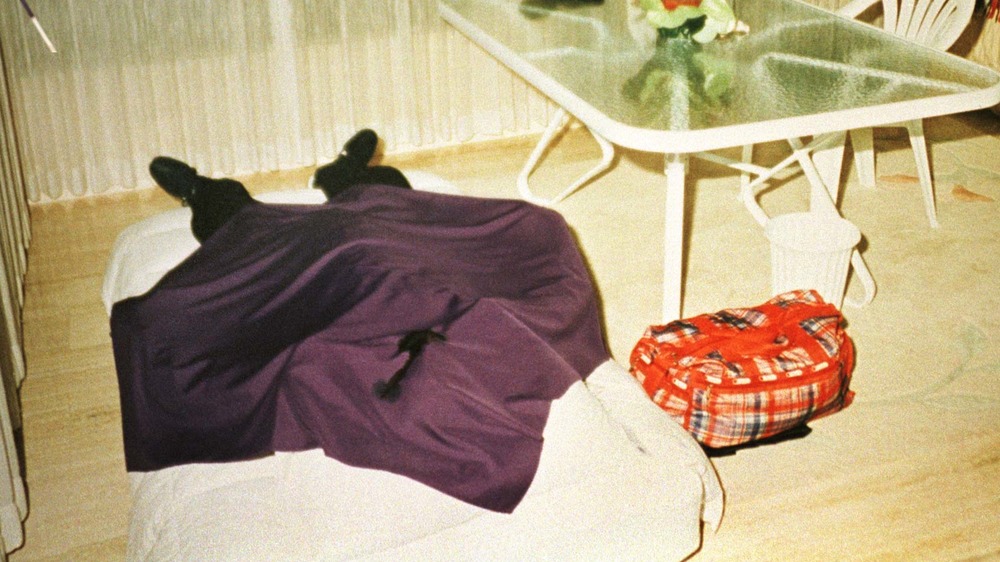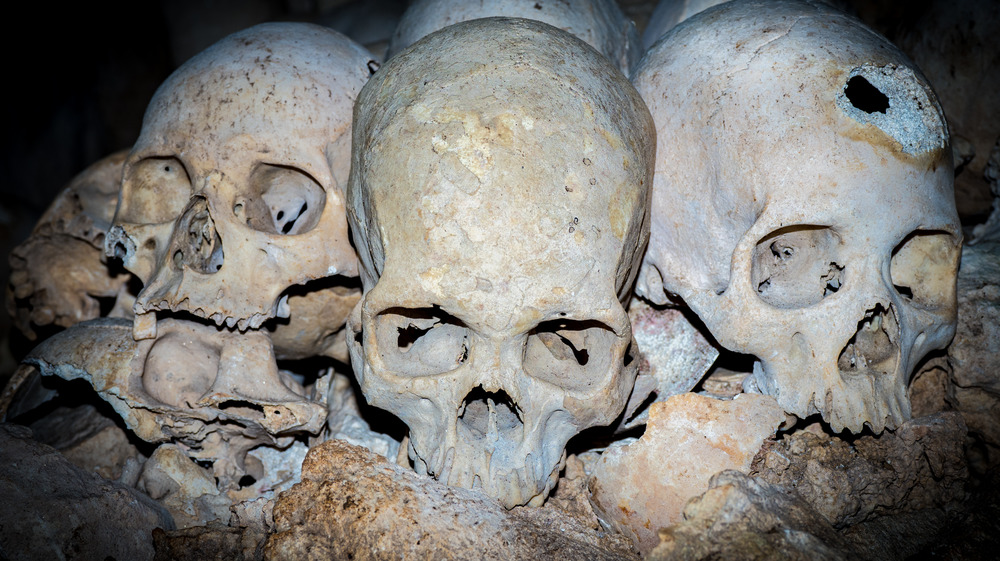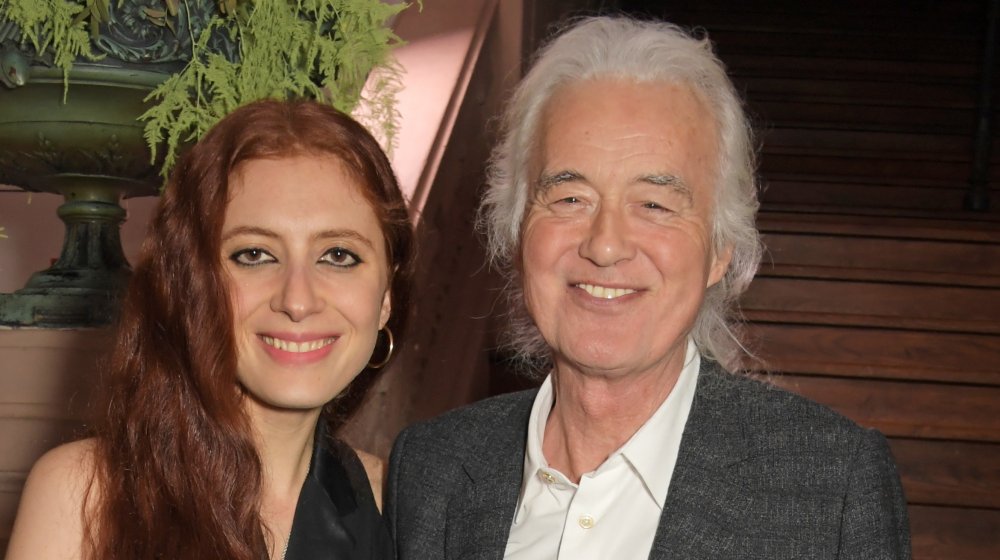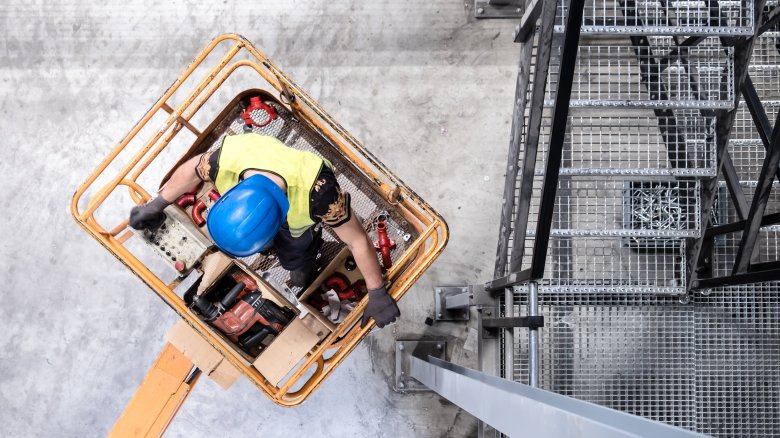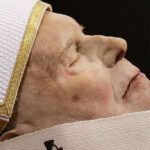
Here’s What Happened To The Bodies Of These Popes
Much is made of a pope’s life, and rightfully so. The pope is the spiritual leader of Catholics worldwide, not to mention the temporal leader of the Vatican City, where he’s technically the absolute monarch of the tiny nation (via PBS). Pontiffs have also often wielded some pretty serious political power throughout history. Take the medieval Pope Innocent III, whom The Florida Times-Union notes was one of the most powerful Holy Fathers ever. Innocent ordered multiple crusades in the Holy Land and was, on multiple occasions, the person who gave the all-important go ahead for a nation to crown a new ruler.
Today, though no one’s really all that concerned about the pope raising an army, they still have to contend with him as a political leader who can send ambassadors, according to The Conversation, and who can deploy some not inconsiderable diplomatic power.
Popes, therefore, can have a pretty profound effect on the world while they’re alive. And that visibility and veneration of their lives tends to carry on through their deaths. Even the humblest of popes can expect to have a relatively elaborate, highly ritualized funeral. Some, attempting to reform the traditions dictating the treatment of their bodies after death, produced plenty of trouble for their surviving staff. And one living pope in the 9th century was so insecure that he rekindled an old fight, even though his papal predecessor and rival had been dead for some time.
Most popes go through a complex burial ritual
While popes can dictate some details of their funeral ahead of time, the force of history has proven to be pretty strong when it comes to papal send-offs. Most popes therefore go with long-held traditions.
According to the BBC, those traditions can get pretty detailed. A pope’s body will naturally be dressed in the sort of religious garb he would have worn during life. It’s then placed inside the first of three coffins, a wooden one that’s supposed to represent the fact that the pope is but a simple man. It’s eventually placed inside a somewhat fancier zinc coffin with his name and the dates of his reign engraved on the surface, hermetically sealed against the outside world, and then put inside a second wooden coffin, this time made of oak. The whole assembly is placed beneath a marble slab or, in the case of some pontiffs, inside an entire marble sarcophagus.
Those aren’t the only rituals closely followed in the wake of a pope’s death. CBS News reports that the Vatican observes a 9-day mourning period that’s linked to ancient Roman custom. It also typically involves a public viewing. The funeral itself must take place between the fourth and sixth day after the pontiff dies, though it’s not immediately clear why. After the service in St. Peter’s Basilica, the pontifical coffin is carried out through an ominously named “door of death” for the final internment beneath the church.
Some remains of popes may be combed over for relics
After their deaths, popes’ bodies may be preserved as wholly as possible for “future veneration,” according to The Christian Century. Though that statement is carefully vague, many interpret it as the collection of holy relics from the remains of previous pontiffs. Relics, after all, have proven to be a pretty big spiritual business throughout the history of the church. These relics are believed to be a direct physical connection to a saint and can be drawn from any number of body parts, from St. Anthony’s tongue to St. Catherine’s head to the bones of the first pope, St. Peter (via The Guardian).
This all may well be why Pope Benedict XVI, the pontiff who famously resigned from his post in 2013, learned that his organ donor card was no longer accepted. Federico Lombardi, the chief spokesman for the Vatican, claimed that it had nothing to do with the possibility that Benedict’s future remains would be reserved for relic-collection if he were declared a saint, but that did little to dispel the theory.
It’s certainly happened before. The Guardian reports that, on multiple occasions, relics from Pope John Paul II (who was made a saint in 2014) were stolen. One was a piece of the blood-stained robe he had been wearing during a 1981 assassination attempt. Another was a vial of blood collected towards the end of his life, which was stolen from Spoleto, Italy in 2020.
Pope John XXIII went on display long after his death
People really, really loved Pope John XXIII. He was a widely admired pontiff, to the point where he became known simply as the “good pope” for his welcoming nature and relatively liberal attitudes. According to ABC News, he was the pope who oversaw the Second Vatican Council, a major development in church administration and theology that sought to bring Catholicism in line with more modern ideals.
Given how much people venerated John XXIII despite his short reign from 1958 to 1963, it’s no wonder that there were soon rumors of his purported sainthood. He was linked to a nun’s disappearing stomach tumor, for one. And when his tomb was opened in 2001, his remains were in extraordinarily good condition. Per ABC News, Cardinal Virgilio Noe even said that “it was as if he died yesterday.”
However, the church has remained skeptical about incorruptibility. ABC News reports that John XXIII’s remains were not embalmed but had been treated with formalin for public viewing. The Irish Times goes so far as to say that he was “heavily embalmed,” while the Vatican reminded everyone that John XXIII’s remains were also hermetically sealed inside multiple coffins. Nevertheless, the pope’s remains were put on display in 2001 in a glass-sided coffin for public viewing. The Los Angeles Times also notes that the body was outfitted with a wax mask made from a casting of the pope’s face made just after his death.
Pope John Paul II wasn't embalmed
It doesn’t appear that the Catholic Church has an official policy regarding whether or not a pope’s remains should be embalmed. However, we do have some clues, if information about more modern papal funerals is anything to go by. According to Slate, a number of recent popes have been fully embalmed after their deaths, including all of the four popes preceding John Paul II. The full embalming process requires removing nearly all blood and other bodily fluids from the remains, replacing them with a preservative-heavy solution that also contains dye meant to give the body a more lifelike appearance.
In contrast to earlier tradition, John Paul II appears to have not been fully embalmed. According to the Vatican, his body was only “prepared” for a public viewing. This vague statement leaves a fair amount of room for interpretation, but it’s likely that the pope’s body was given some sort of treatment with preservatives to keep it in a presentable (that is, not visibly decomposing) state.
After all, Pope John Paul II died in 2005, well into an era where reporters and news cameras could broadcast any issues spotted during the public viewing, while thousands of people were filing past his remains. While some reported telltale signs of deterioration, it appears that whatever the light treatment that was applied to Pope John Paul II’s remains, it worked far better than for other popes who experienced similar preparations.
The body of a pope might be exhumed and moved multiple times
Though, for many, a final resting place should be well and truly final, that’s not always the case for some mortal remains. A famous person might rest pretty uneasily, as fans and researchers alike fail to resist the temptation to dig some people up for just another look. And, like some other notables, especially within the Catholic Church, a pope may not expect to rest in a single spot forever. If a pope is the subject of a sainthood cause, then their body may in fact be removed from its burial place multiple times over the decades. Vatican officials may want to exhume a pope’s remains to put them on public view for veneration or to inspect the remains for signs of sainthood, for instance.
Consider the remains of St. John Paul II. Before he was officially canonized in 2014 (via CNN), his body was taken up out of its burial place in the crypt of Saint Peter’s Basilica and placed back in front of the church’s main altar, according to Reuters. Thereafter, with beatification achieved, the coffin was put into a new burial spot in a nearby chapel, with the marble topper from his old sarcophagus sent to the pontiff’s old home country of Poland.
Pope Pius X stopped an embalming tradition he found extra creepy
Though much is made of the ancient and storied traditions that are part of life in the Vatican, things can and indeed do change. Sometimes, those changes are sweeping, even monumental, like those enacted by the Second Vatican Council in the 1960s. Per Britannica, Vatican II, as it’s often called, loosened rules for some religious order members and allowed for mass to be held in numerous local languages and not just Latin. It was also, of course, fairly controversial and led some conservative members of the church to complain well into the present day.
Then again, sometimes the changes to tradition are seemingly small, though they can have big consequences later. Take Pope Pius X, who died in 1914. According to the L.A. Times, he refused to allow embalmers to remove his internal organs and preserve them in separate jars. It was by then a pretty well-established practice that had been enacted in the wake of previous popes’ deaths.
But Pius X thought this all was nothing short of grotesque and his successors seemed to agree. Yet, where the remains of Pius X seem to have suffered no great damage from this new tradition, other popes’ bodies — with quickly deteriorating organs still intact inside them — would not be quite so fortunate.
Pius XII went through a disastrous embalming process
No one seems to know why, exactly, Riccardo Galeazzi-Lisi was put in charge of embalming the pope. The scheming, incompetent personal doctor of Pius XII wasn’t exactly a figure who inspired confidence when he appeared in the papal apartments. And it was eventually revealed that he was behind the deathbed photos of the pontiff that had been leaked to the press in 1958, per Ozy.
The embalming was a disaster, not least because Galeazzi-Lisi was a quack who had made promises he simply couldn’t keep. Together with another presumably incompetent surgeon, he had developed an “aromatic osmosis” method that had supposedly been used by the ancients. It basically required that someone dress the body in various oils and then wrap it in a sheet of plastic, with no injections or incisions.
The process did absolutely nothing to slow down the decay of the remains, ultimately producing smells so bad that members of the Swiss Guard reportedly fainted while standing guard around the coffin. Even worse, the pope’s remains were so bloated with gases produced via decomposition that they popped within his coffin — in the middle of his funeral procession in Rome. Galeazzi-Lisi and associates hastily re-embalmed the remains, but it was still pretty awful. Some even reported that Pius XII’s remains had turned a lurid “emerald green” because of Galeazzi-Lisi’s lackluster ministrations.
The Cadaver Synod brought a fight between popes to a gruesome head
While there’s plenty to shake one’s head at when it comes to relic hunting and experimental embalming, those mishaps can’t measure up to the infamous Cadaver Synod. It essentially began in 897 CE, when Pope Stephen VI decided that his predecessor, Pope Formosus, had committed a great sin (or had proven to be politically inconvenient to Stephen’s way of doing things). According to Atlas Obscura, Formosus had once been a pretty powerful bishop. Pope John VIII got so nervous that he had Formosus excommunicated. John was eventually killed and his successor reinstated Formosus, who managed to snag his own spot as pontiff for five years before dying. By this time, the papal throne had a pretty high turnover rate, and anyone sitting there was bound to feel pretty nervous.
So, Stephen VI held a trial for Formosus, whom he believed had broken some key rules when he became pope. Stephen had his predecessor’s remains exhumed, dressed in liturgical robes, placed in a chair, and put on trial.
Being dead, Formosus was not really able to defend himself against the charges and was quickly found guilty. National Geographic reports that his remains were unceremoniously tossed in Rome’s Tiber River, where a fisherman pulled the body out of the water. Formosus’ remains were soon linked to rumors of miracles. Stephen was unsurprisingly felled by an uprising and the body of Formosus was reinstalled in a tomb beneath St. Peter’s Basilica.
No one is totally sure what happened to Saint Peter's body
When it comes to popes, Saint Peter is kind of a big deal. It’s not only that he was an original apostle of Jesus and in fact the head honcho of the 12 apostles, per Britannica. There’s also the matter that, according to widespread Christian tradition, Peter was the first-ever pope. Like so many saints in early Christianity, legend maintains that Peter met a gruesome end, crucified upside down by authorities under Roman Emperor Nero.
All of this means that any relics recovered from the mortal remains of Saint Peter would be pretty highly venerated amongst the faithful. Yet, while bones that reportedly belong to Peter have been displayed in the Vatican, Smithsonian Magazine reports that the circumstances of these bone fragments’ recovery and identification are unclear. The remains were taken from an ancient burial ground under St. Peter’s Basilica uncovered after 1939. It’s indeed possible that early Christians would have wanted to be buried near a big-name apostle.
Yet, as The Guardian notes, no pope has ever gone so far as to definitively state that these nine bone fragments belong to Saint Peter. In 1968, Pope Paul VI did claim that the bones were “identified in a way we consider convincing,” but offered precious little evidence beyond that. Skeptics therefore remain, well, skeptical, while believers will have to decide whether or not they want to take it as a matter of faith.
Pope Paul VI also had a pretty disastrous funeral
Pope Paul VI’s remains were only “lightly embalmed” after his 1978 death, according to the Los Angeles Times. While that seemed to have worked out decently enough for one of Paul’s successors, John Paul II, the reality of the 1978 funeral was quite a bit more gruesome. Part of the issue may have been with not only the manner in which the deceased pontiff’s body was treated, but with the environmental conditions in the midst of what seems to have been a hot and humid summer.
The combined effects of the lack of embalming and the summer weather were unfortunate for Paul VI and his mourners, to say the least. Reportedly, a number of fans were installed around the pope’s remains as they lay in state inside St. Peter’s Basilica. It was done in order to somehow redirect the stench during the public viewing, according to Ozy.
Meanwhile, The Washington Post reported that, though then-First Lady Rosalynn Carter spoke glowingly of the pontiff’s spiritual life, some couldn’t help but notice that the pope’s body had turned an alarming green-gray color. The Vatican declined to say just what had or had not been done to Paul VI’s remains in the immediate aftermath of his death, but it was clear that it hadn’t been enough to stand up to the rigors of a summertime memorial.
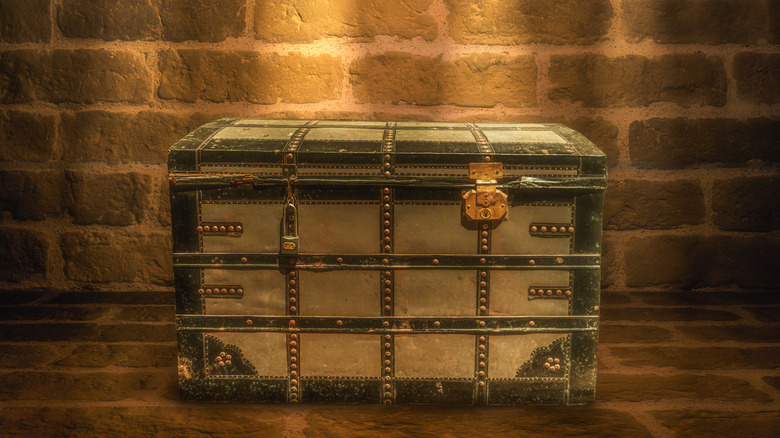
The Most Unbelievable And Valuable Things People Have Found In Attics
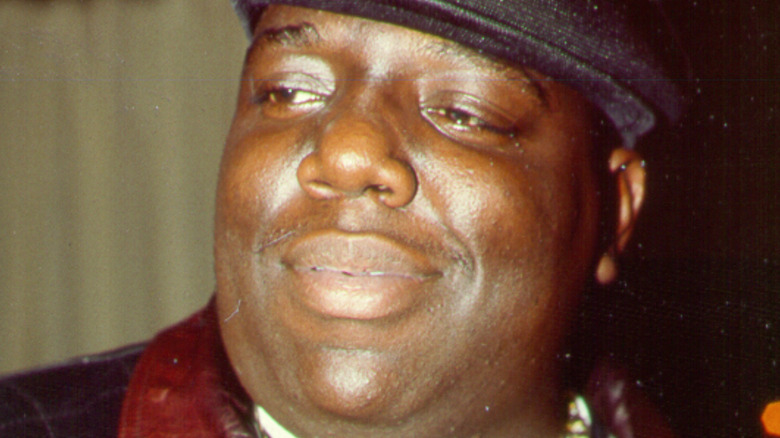
Is Biggie Smalls Buried Anywhere?

This Theory Connects Atlantis And The Black Sea Flood

The Biggest Disasters In Space History
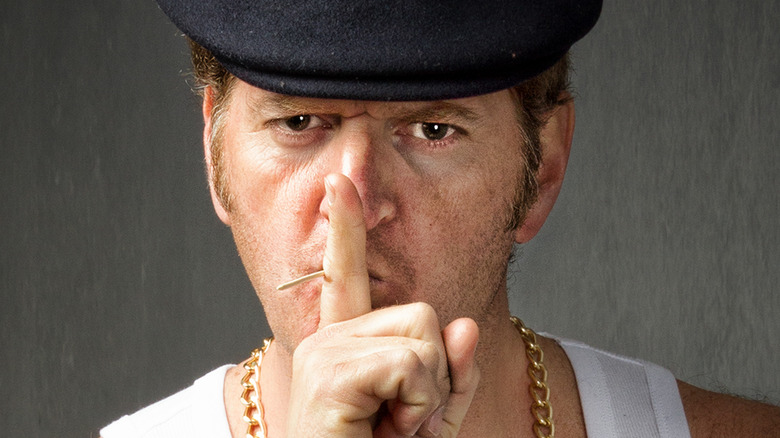
This Is How The Mafia Got Started

The Weirdest Ways People Have Tried To Tell The Future
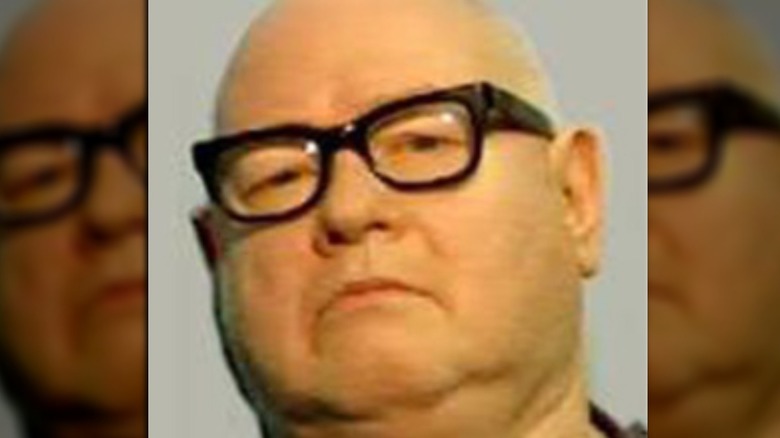
What Serial Killer Jerry Brudos' Childhood Was Really Like
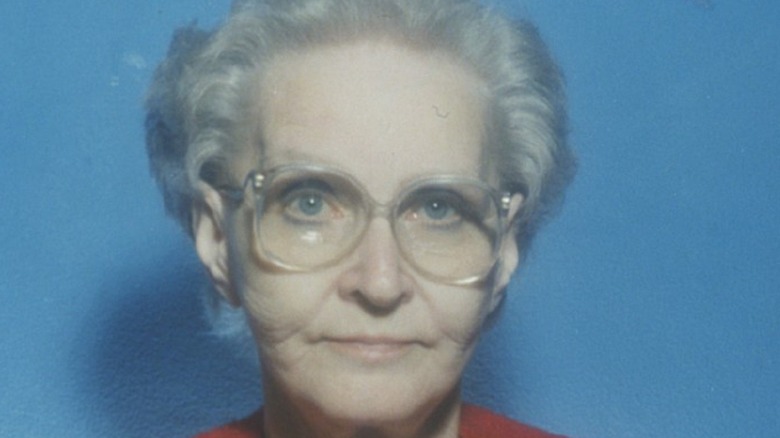
Did Dorothea Puente Ever Confess To Her Murders?

Why The Sydney Opera House Was Nearly Not Built

Marina Chapman: Whatever Happened To The Girl Raised By Monkeys?
